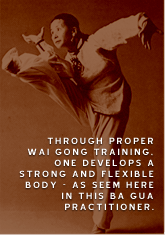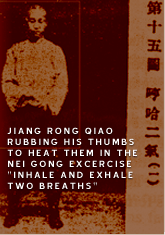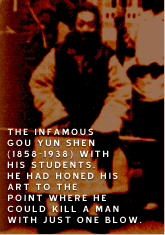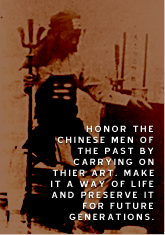 |
In
Ba Gua Zhang systems there are any number of forms and exercises associated
with wai gong training. Basic stance work, straight-line and circle walking
stepping drills, hand movement exercises, kicking sets, straight-line repetition
of movements, straight-line linked forms, various cir4cle walking drills, apparatus
training, power training with weapons, numerous two-person sets, etc. Each system
will have their own approach. There are also numerous circle walking exercise
working with different types of stepping exercises working with different types
of stepping methods and upper body postures which develop the body and leg strength
in a variety of ways.
Nei
Gong
Nei Gong is training which is designed specifically for the development of muscle
groups, ligaments, and tendons not usually under conscious control. This training
involves refinement of the basic wai gong skills and development of the connection
between mind and body. In the beginning levels of nei gong training, repetitive
physical movements are combined with:
|
1)
relaxation of all muscles which are not directly involved with the particular
action being performed
2) breathing in coordination with the motion
3) simple imagery (use of intention).
The combination of relaxed physical movement, breathing, and intention begins
to teach the practitioner how to move in a highly refined manner and facilitates
the development of subtle strength and efficiency in movement.
|
Today
some people in the internal arts are fond of saying "use no strength, let the
qi move your body." Reality check! I'm sorry folks, if your body is moving you
are utilizing muscles and strength. Don't let them get away with that "it's the
qi" dodge. Whenever anyone tells me "it's the qi" or "use the qi" my mind translates
it to mean "I don't really know what I'm talking about so I will say something
very nonspecific and people will think I am an expert." The top level Xing Yi
and Ba Gua instructors that I have met in mainland China and Taiwan rarely ever
even use the word qi when they are teaching beginners. But here in "new age" America
we find that word everywhere and there are people who will believe anything is
possible as long as they are told "the qi" is doing it.
It
is amazing to me how otherwise intelligent individuals will suspend all rational
thought and common sense when someone mentions the word qi. Yes. I do believe
in qi. However, I believe it is not something to be worshiped or sought after
as "the ultimate goal" and it is not something that is magical or mystical.
|

|
Proper
internal martial arts training facilitates strong, full, and balanced qi in the
body. This certainly helps the practitioner's "internal power." However, if the
proper alignments, proper use of refined strength, proper body coordination and
timing of the body movements, and correct, natural and efficient use of the body
in conjunction with the mind and the breath are not trained correctly, the practitioner
who is worried about obtaining "qi power" is dreaming. If those other things are
in place, the qi will naturally be there, if they are not, you are out of luck.
"Proper use of strength" in the internal martial arts means that the strength
is not "clumsy." In executing any movement, if the practitioner is utilizing muscles
that are not directly involved in that movement, if the breathing is not coordinated
with that movement, or if the mind is not fully involved in that movement, then
the movement is "clumsy." The classics of internal boxing all warn the practitioner
against the use of "clumsy force."
Nei gong training teaches the individual how to use the body strength in the most
natural and efficient manner so that it is not "clumsy." Simple repetitive exercises
which teach the practitioner to coordinate mind, body and breath are all that
is required in nei gong. It doesn't need to get any fancier or more sophisticated
than that. Wild visualizations exercises which tell you to "imagine the energy
of your large intestines connecting with your lungs, moving out your middle dan
tian, wrapping around your body four times counterclockwise and then sucking back
in to your body through your third eye" are not going to get you ver far in the
internal martial arts. In my opinion, in the context of obtaining martial arts
skill, it is simply mental masturbation. Sure you might get a little "qi buzz"
happening, but this kind of qi development is usually not very functional in martial
arts. Additionally, forced movement of energy in the body through strong mental
visualization is potentially very dangerous.
The majority of the overly complex nei gong and qi gong which people are practicing
today is coming from what I call "fad" qi gong books written by individuals who
are appealing to the overly intellectual Western mind and overly lazy Western
body by promising better health through mental gymnastics. I can't believe the
number of phone calls and letters that I get from people that are overly concerned
about things such as "connecting the governing and conception vessels" (Ren Mai
and Due Mai) through meditation so that their "microcosmic orbit" or "small heavenly
cycle" will be "complete." First of all, if your Ren Mai and Du Mai are not connected,
you are probably dead. Secondly, if you are concerned about increasing the full
and balanced flow of qi in these meridians, you should not be sitting in a chair
and trying to do it with your mind. Correct movement combined with simple imagery
and gentle breathing will do it for you in a simple, progressive, and safe manner.
In the book Shen Gong written by Wang Lian Yi, the son of the famous Xing Yi Quan
master and Chinese Medical doctor Wang Ji Wu, (1891 - 1991, see photo on page
10, Pa Kua Chang Journal Vol. 4, No. 3), it says:
"If the qi circulation in the Ren and Du meridians is strong, the "Small Heavenly
Cycle" is open and there are great benefits to health, including increased metabolic
activity, increased resistance to disease, increased powers of recover from illness
and leading to a long and healthy life. While qi circulation in the Ren and Du
meridians is a vital part of maintaining health, Wang Ji Wu felt that the beginner
should not try and force the qi to flow through strong intention. His advice was
to practice the exercises with a relaxed mind and the intention focused on the
dan tian. After the qi has gathered in the dan tian, it will find its own way
in the "Small Heavenly Cycle" through the gentle coaxing of the physical movements."
All of the good teachers that I have been exposed to have the same advice for
beginners. Don't force things with the mind that can be accomplished just as easily,
fully, and safely, with gentle concentration and simple body movements. Through
experience I have learned that they are correct. I myself practiced those "fad"
methods for years. While I did indeed feel some partial benefits from these practices,
the results were not nearly as great, or as functional, as the results I obtained
through the practice of much simpler methods. Personally, I found that physical
movement in coordination with the breath and very simple mental imagery was far
more practical and beneficial.
In the chapter on Nei Gong in the Written Transmissions of Xing Yi Quan it states:
"If the dan tian is lacking, the ai will not be sufficient. With insufficient
qi, power will be inadequate. The five elements and the twelve forms will be empty.
In this state, in defense one will be as a city surrounded by a dry moat, in attack,
one will be like a strong soldier with a weak horse. One must practice Xing Yi
Quan diligently everyday. Sitting in meditation trying to become immortal will
not cultivate the dan tian.
All of the nei gong I have been taught in mainland China and Taiwan by individuals
who I would consider top rate martial artist was very simple, practical, and effective.
Again, simple repetitive movements combined with simple imagery and executed in
coordination with the breath is the most effective way to practice.
In Ba Gua Zhang much of the nei gong work is accomplished through nei gong exercises
which are similar to things like the ba duan jin (eight section brocade) however
they have more of a Ba Gua twisting and turning flavor. There are also other basic
hand and body movement exercises and the circle walking practice while holding
the "eight mother palms," which are included in the nei gong training.
Every Ba Gua system I have encountered has their version of the eight mother palms.
These palms are also sometimes called the qi gong palms, the nei gong palms, the
"inner palms," or "the basic palms," but the practice is the same. The student
walks the circle while holding static upper body postures and executing simple
directional changes. Concentration is placed on maintaining a stable dan tian,
the breathing is smooth, continuous, and natural, and there is a simple mental
image associated with each of the eight palms and the transitions between the
palms. This practice is the core of nei gong in Ba Gua. |
Qi Gong
Qi Gong training consists of breath control, simple visualization, meditation,
and nonspecific body movement techniques and exercises for various purposes including
increased circulation of qi and blood to the distal points of the extremities,
increased vital capacity, increased mental focus, and increased whole body strength.
These methods typically consisted of very straight-forward exercises designed
to strengthen the body internally and increase mental focus. These exercises and
techniques are a far cry from the "new age" qi gong of today which consists of
a mixed bag of incomplete practices from various disciplins stirred up in a pot
of mysticism and esoteria and promising results of "qi power" and "spiritual enlightenment."
The qi gong which the internal martial artists practicied was simple and the results
where obtained gradually. Simple practice and gradual development in qi gong insures
a safe practice. Any qi gong practice which promises quick results is probably
dangerous. |

|
Much
of the "quick results" qi gong which is written about and practiced today was
taught in China to soldiers in time of war.
Obviously in war time it was necessary
for the soldiers to be trained quickly. It was also no concern of the people training
the soldiers whether or not the soldiers developed side effects from the training
years down the road or died at a young age as a result of the training. The war
was now and the soldiers had to be strong and tough now. Unfortunately, after
the war the surviving soldiers went home and taught these methods in their home
villages. Lineages where formed and so we are left with these dangerous practices
today. In many cases the damage done by bad qi gong will not show up for many
years and so people did not usually connect the illness with the qi gong. Practices
such as "Iron Shirt," "Iron Palm," and hanging weights from the testicles are
the very worst of the practices which fall into this category.
Much of the "dangerous" qi gong methods mentioned above which were taught in war
time originated in places like the Shaolin temple. In the temple the monks who
practiced these methods did not take the same risks as the soldiers because they
had time to develop these practices slowly and gradually and they led a lifestyle
which was conductive to this kind of development. Their meditation practices,
diet, daily schedule, and herbal supplements all served to keep the body in balance
while performing these exercises. When these practices were separated from the
monastic lifestyle, and thus practiced incompletely, they became dangerous and
while producing quick results, they were very harmful in the long run.
Other qi gong methods, from both the Daoist and Buddhist traditions, underwent
a similar transformation when they were taken from the temples and taught to the
general public. More times than not the transmission was incomplete and when the
practice was separated from the lifestyle of a monk, it became potentially dangerous.
Good qi gong practice is very simple and the results are obtained gradually.
|

|
Mixing
the Ingredients
Even if a Ba Gua teacher is teaching elements of all of
the above training methods, it still may not come together to form what I would
call a "complete system." What is listed above could be analogous to ingredients
required to prepare food. If you were to possess all of the ingredients to make
a certain food, but did not know how to mix the ingredients appropriately, how
to prepare and cook the ingredients, and how to add the spices, you could not
prepare the food properly. Martial arts training is similar. Just because a
teacher has a grand list of exercises, forms, and training methods does not
mean he has a system. There are a great many teachers of Ba Gua in the United
States today who have a hodgepodge of forms and exercises from various systems
and sources and they do not really know how to put them together to train students
effectively. They have a lot of ingredients, but no recipe.
|
If
the teacher shows the student "Sun Lu Tang's form" this month, "Jiang Rong Chia's
form" next month, adds in "Wang Shu Jin's form" two months down the road, and
then supplements the forms with ba duan jin and "iron shirt" and shows you his
"fighting training" which simply consists of his interpretation of "the application"
of each of the form movements, you are simply following him down his road that
leads to Ba Gua Nowhereland. Complete martial arts training programs are very
systematic. Like building a house, there is a plan. A strong foundation is built
and then each piece is added sequentially and everything fits in its place. When
the plan has been followed, there are no missing pieces in the end.
A good teacher with a complete system will be able to show the student how to
practice each exercise and form, be able to explain why each exercise is being
practiced, how it fits into the overall picture, and where it is leading to next.
Additionally, the teacher will also know how to vary the program from one student
to the next in order to fit each student's individual needs based on age, sex,
coordination, experience, strength, build, constitution, health concerns, etc.
Not ever student can be taught the same way. Every complete martial arts method
has a systematic program and each teacher knows how to vary that program to bring
out the best in each student.
Conclusion
In order to raise the level of Ba Gua practiced in the United States, I feel that
it is important for students to strive to learn a complete Ba Gua system. Let's
put an end to the fragmentation that has occurred over the last 70 or 80 years.
This is the only way this art will continue to grow and flourish. Ba Gua is not
"a form," it is a system. If you are teaching Ba Gua, you know whether or not
you have a complete system. If you are teaching fragments, complete your training.
Eat some humble pie and search out an instructor who has a complete method so
you can fill in your own missing pieces and pass a complete art along to your
students.
More than one Ba Gua "teacher" in this country is out there teaching Ba Gua forms
to students that they picked up from video tapes, weekend seminars, or a two week
trip to China. This typically occurs with teachers who have been trained in one
system, like Shaolin Tai Ji, or Xing Yi and have students that also want to learn
Ba Gua. In order to keep their students, they quickly run out and buy a video
or take a seminar and then teach what they learned the next week. It is sad, but
it is not an uncommon occurrence. Again, if you are a martial arts teacher and
want to teach Ba Gua, spend some time really learning Ba Gua yourself before trying
to teach it to someone else. Learn Ba Gua as Ba Gua, don't learn a Ba Gua form
and then try to guess how all of the moves are used based on your knowledge of
Tai Ji, Xing Yi, or Shaolin. You will not get it right.
If you are a student, take a hard look at what you are being taught and decide
whether or not it has everything you are looking for in a martial art. Ask your
teacher to explain his system and how each of the components fit together. Use
common sense. Do not be fooled by explanations that sounds too general, promises
of results that sound unrealistic, or training that seems too easy. Good Ba Gua
training is extremely difficult.
If you feel your teacher is a good martial artist and you would like to obtain
his skill level, ask your teacher about his background and how he was trained.
If he talks about how his teacher made him walk the circle for hours in a low
posture and made him repeat simple form movements everyday for months before he
would be given the next section of a form, then he should be teaching you that
way. Otherwise, you are probably never going to be as good as he is. Use common
sense. Don't allow a teacher to "sell you," let him convince you through your
own progress. Don't let a teacher tell you that you have to practice for ten years
to get internal power. A student that practices hard should develop a good deal
of power within the first year or two of training. It will take years to further
refine that power, however, if you have been studying Ba Gua for two or three
years and haven't already greatly improved your internal power, something is missing.
Editor's (Dan Miller) Note: I realize that this two part article has in some
ways been quite negative and will probably upset some people. What I have expressed
here are my personal opinions based on my experiences. If others have opposing
opinions based on their experiences, that is fine, they are entitled to them and
I respect each person's individual opinion. If you feel like expressing your opinion
to our readers, write to me and I will gladly print it. As a journalist I feel
that if I "sugar coated" everything I wrote so that I would not upset anyone,
I would not be doing my job. I feel it is my duty to conduct my research as thoroughly
as possible and then to express my honest opinion based on that research. I do
not ask that everyone see things my way, I only ask that readers consider what
is said. Again, I feel it is a writer's job to get people thinking, not to make
everyone feel good about themselves.
Originally published in the Pa Kua Chang Journal - July/Aug
94
Used with permission.
|
|
|
|
|
|
